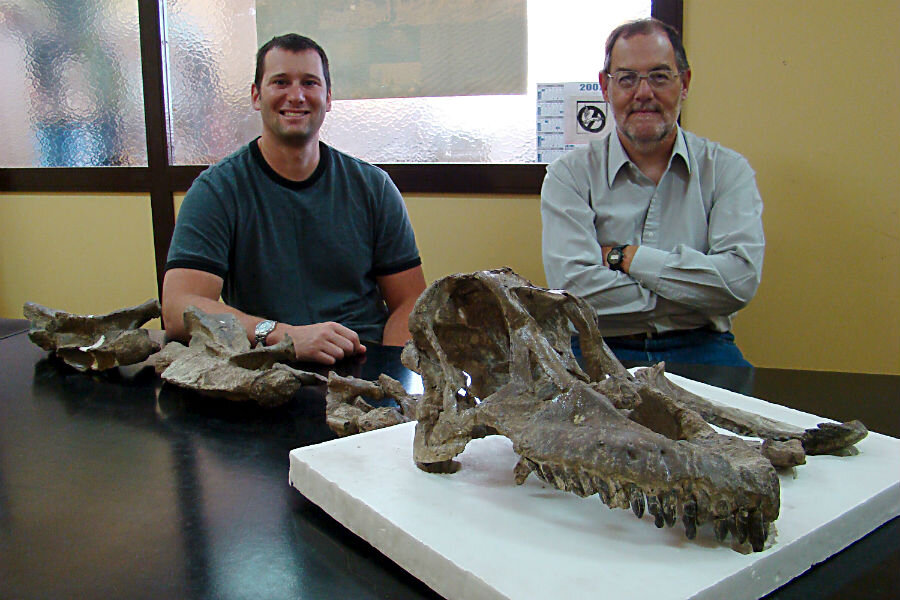'Once in a lifetime' dino find yields new titanosaur species
Loading...
Scientists have discovered a new Cretaceous-period species of dinosaur, thanks to a fossilized skull and partial neck recovered in the central plains of Patagonia, Argentina.
While sauropods have been studied for years, full records of the long-necked herbivores are rare, and only four of 60 known titanosaurs, giant sauropod common to South America, have been found with at least semi-complete skulls.
Sarmientosaurus musacchioi lived about 95 million years ago, weighed eight to 12 tons, and was around 40 to 50 feet long, making it an average-sized titanosaur for its time, researchers led by Rubén Martínez of Universidad Nacional de la Patagonia San Juan Bosco reported Tuesday in the journal PLOS One. The largest dinosaurs in the group were 100 feet long and could weigh up to 100 tons.
While the Sarmientosaurus found by Dr. Martínez and his colleagues was not complete, the “superbly-preserved adult skull” allowed the researchers to learn the most about the species.
“The head is key to understanding an animal's biology. It's home to the brain, sense organs, jaws and teeth – food-gathering mechanisms – and more,” Carnegie Museum of Natural History paleontologist Matt Lamanna told Reuters.
The fossil was located in the green sandstone of the Bajo Barreal Formation of Patagonia’s Chubut Province, an area home to several other Cretaceous dinosaur fossil finds, although the well-preserved skull could be one of the best yet taken from the geological formation.
“Discoveries like Sarmientosaurus happen once in a lifetime,” Martínez in a press release. “That's why we studied the fossils so thoroughly, to learn as much about this amazing animal as we could.”
Their findings included clues about the Sarmientosaurus’s cognitive abilities, body structure, and habits. The fusion of bones in the skull suggested to the researchers that the specimen belonged to a “possibly very old” creature, and that, despite its massive size, it probably wasn’t very smart.
“Sarmientosaurus, bless its heart, was not the sharpest tooth in the jaw,” Ohio University anatomist Lawrence Witmer told Reuters. “Sauropod dinosaurs in general are famous for having the smallest brain size relative to body size, and Sarmientosaurus was no exception.”
The study has also yielded information about Sarmientosaurus vision and hearing. The titanosaur had large eye sockets, suggesting large eyeballs, and long hearing ducts. Those two measurements most likely mean the creature relied heavily on sight and being able to hear noises from far away.
The positioning of its inner ear also suggests that the Sarmientosaurus probably planted its tree-trunk legs and faced downward to feed, “moving that long neck around like the wand of a vacuum cleaner while the head vacuums up all the low-growing plants in the area,” according to Dr. Witmer. It also has a unique tooth orientation distinct from other sauropods, although the scientists were unable to ascertain for certain what that would have meant for the dinosaur’s eating process or diet.
Martínez wrote that the name Sarmientosaurus musacchioi name was derived from the name of a town near the Bajo Barreal site, Sarmiento, and honors Eduardo Musacchio, a former UNPSJB professor and friend of the research team.
This report contains material from Reuters.








